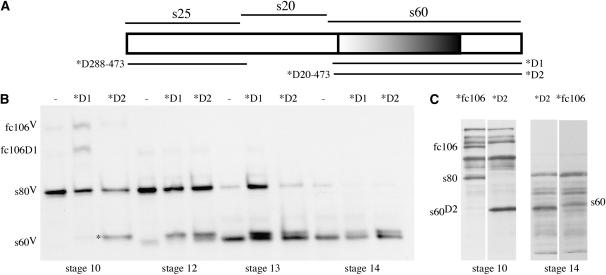Figure 6.—
Expression of fc106ΔQ20–E473 in wild-type and dec-14 mutant egg chambers. (A) A schematic of fc106 with its major regions indicated above. The lines below the schematic indicate the regions that are present in the fc106ΔV288–E473 (*D288–473) and fc106ΔQ20–E473 (*D20–473) transgenes. The abbreviated nomenclature used in B and C is shown to the right. (B) Developmental Western blot of SDS-soluble proteins from wild-type (w/w) egg chambers in the absence (−) or presence of mutant (*D1 or *D2) fc106 cDNA transgenes. Egg chamber stages are indicated at the bottom of each set. The positions of fc106V, s80V, and s60V from the endogenous wild-type dec-1 gene as well as the fc106ΔV288–E473 proprotein (fc106D1) are indicated to the left; the asterisk denotes the s60-like product produced by the fc106ΔQ20–E473 (*D2) transgene. The mobility of this gene product is indistinguishable from that of the s60-like cleavage product of fc106ΔV288–E473 (*D1) (e.g., compare *D1 and *D2, stage 12). The blot was incubated with the Cfc106 antibody. (C) Expression of the full-length fc106 (*fc106) and *D2 transgenes in dec-14 egg chambers. SDS-soluble egg chamber proteins were resolved using a mini-protean electrophoresis cell system. The positions of *fc106 and *D2 transgene products (fc106, s80, and s60 and s60D2, respectively) are indicated against the background of unmarked dec-14 derivatives. The egg chamber stages are shown at the bottom; the blot was incubated with the Cfc106 antiserum.

